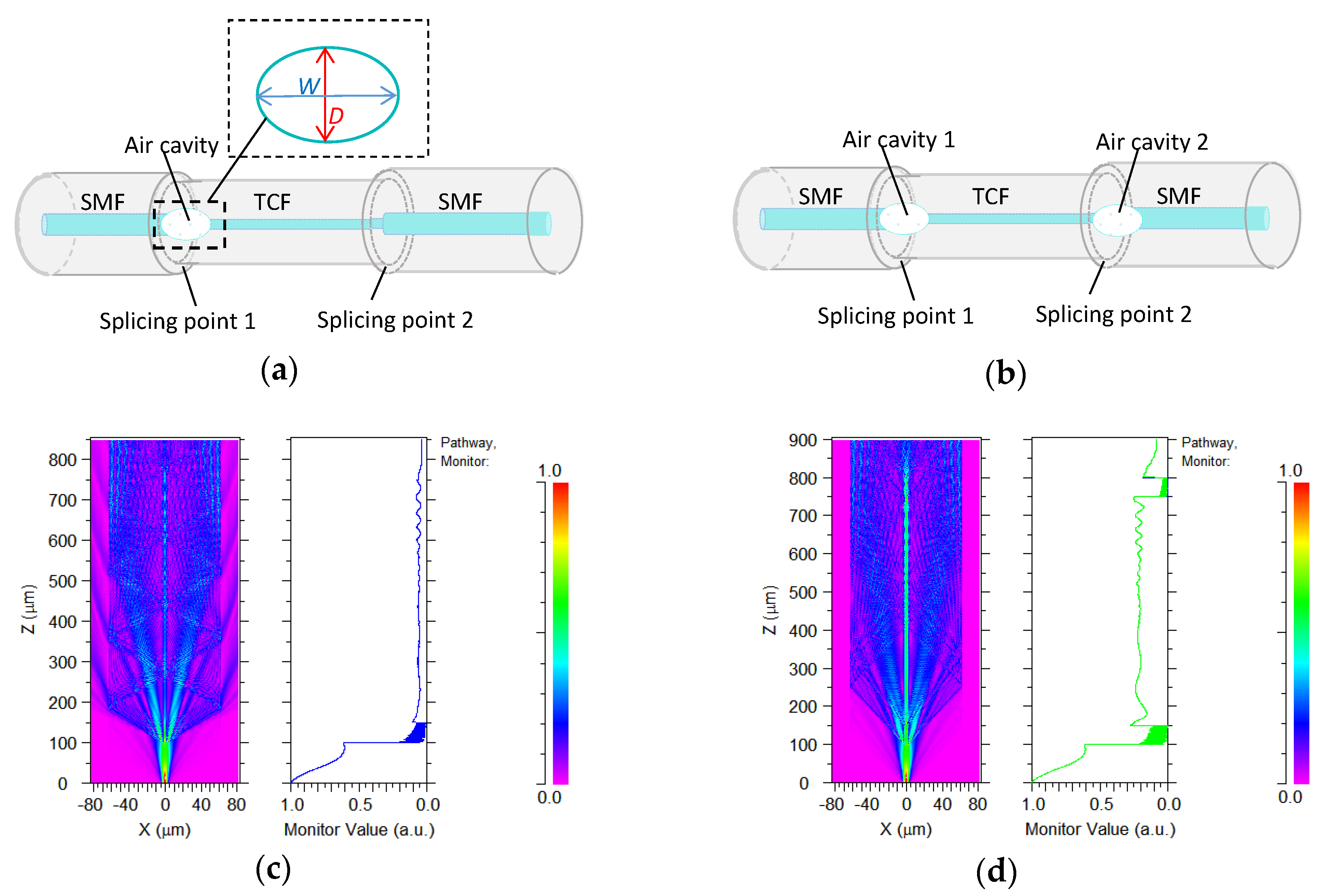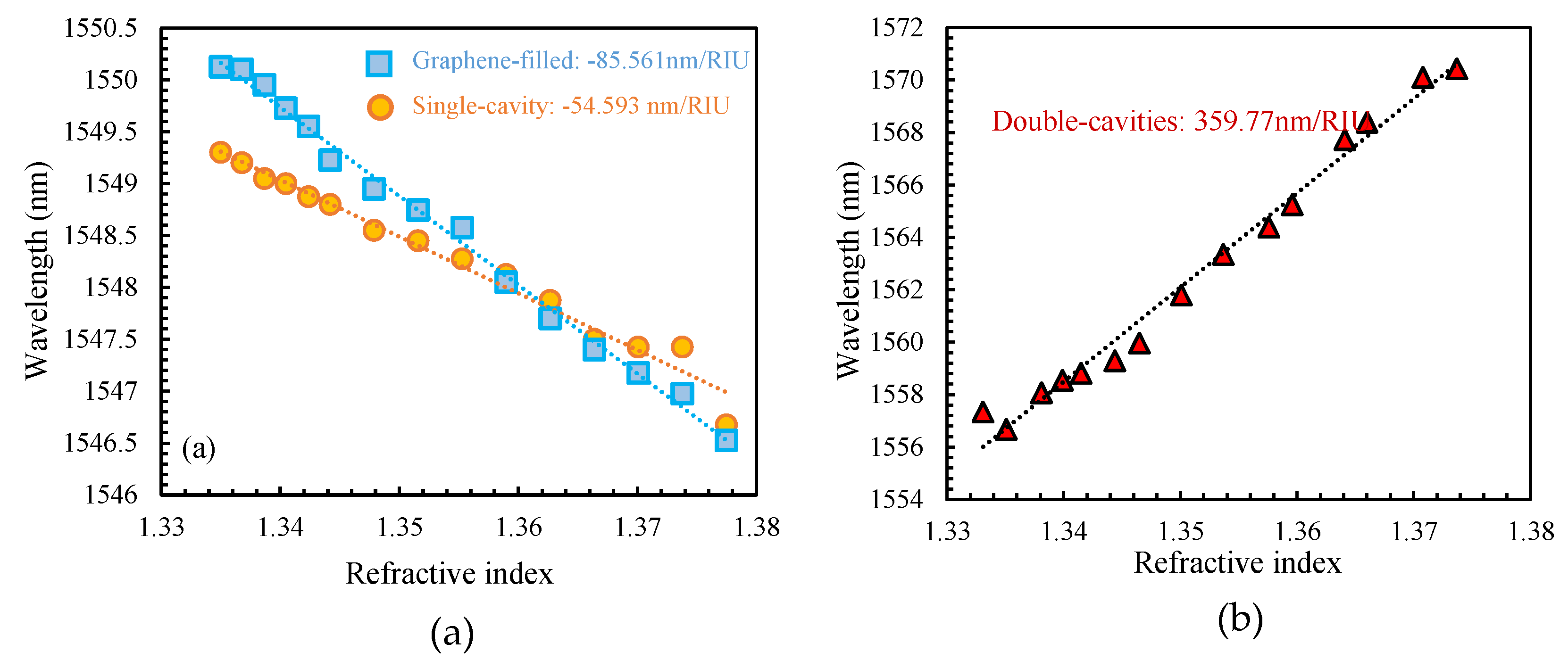In-Fiber Closed Cavity Interferometric High-Resolution Aqueous Solution and Alcohol Gas Refractometer
Abstract
:1. Introduction
2. Principles and Fabrication
2.1. Operating Principles and Simulation
2.2. Sensing Head Fabrication
3. Experimental Results
3.1. Alcohol Gas Concentration Sensing
3.2. Low Concentration Solution Sensing
4. Conclusions
Author Contributions
Funding
Conflicts of Interest
References
- Li, L.; Xia, L.; Xie, Z.; Liu, D. All-fiber Mach-Zehnder interferometers for sensing applications. Opt. Express 2012, 20, 11109–11120. [Google Scholar] [CrossRef] [PubMed]
- Li, L.; Ma, Q.; Cao, M.; Zhang, G.; Zhang, Y.; Jiang, L.; Gao, C.; Yao, J.; Gong, S.; Li, W. High stability Michelson refractometer based on an in-fiber interferometer followed with a Faraday rotator mirror. Sens. Actuators B Chem. 2016, 234, 674–679. [Google Scholar] [CrossRef]
- Zhu, H.; He, J.; Shao, L.; Li, M. Ultra-high sensitivity optical sensors based cascaded two Fabry-Perot interferometers. Sens. Actuators B Chem. 2018, 277, 152–156. [Google Scholar] [CrossRef]
- Li, X.; Nguyen, L.V.; Zhao, Y.; Heidepriem, H.E.; Stephen-Smith, S.C.W. High-sensitivity Sagnac-interferometer biosensor based on exposed core microstructured optical fiber. Sens. Actuators B Chem. 2018, 269, 103–109. [Google Scholar] [CrossRef]
- Zhou, J.; Wang, Y.; Liao, C.; Sun, B.; He, J.; Yin, G.; Liu, S.; Li, Z.; Wang, G.; Zhong, X.; Zhao, J. Intensity modulated refractive index sensor based on optical fiber Michelson interferometer. J. Sens. Actuators B Chem. 2015, 208, 315–319. [Google Scholar] [CrossRef]
- Wu, C.; Liu, X.; Feng, S.; Chen, X.; Li, C.; Wang, Y. High-sensitivity silicon-based photonic crystal refractive index biosensor based on defect-mode coupling. Opt. Commun. 2018, 427, 409–417. [Google Scholar] [CrossRef]
- Sahu, S.; Ali, J.; Singh, G. Refractive index biosensor using sidewall gratings in dual-slot waveguide. Opt. Commun. 2017, 402, 408–412. [Google Scholar] [CrossRef]
- You, K.E.; Uddin, N.; Kim, T.H.; Fan, Q.H.; Yoon, H.J. Highly sensitive detection of biological substances using microfluidic enhanced Fabry-Perot etalon-based optical biosensors. Sens. Actuators B Chem. 2018, 277, 62–68. [Google Scholar] [CrossRef]
- Danaie, M.; Kiani, B. Design of a label-free photonic crystal refractive index sensor for biomedical applications. Photonics Nanostructures-Fundam. Appl. 2018, 31, 89–98. [Google Scholar] [CrossRef]
- Tavousi, A.; Rakhshni, M.R.; Mansouri-Birjandic, M.A. High sensitivity lable-free refractometer based biosensor applicable to glycated hemoglobin detection in human blood using all-circular photonic crystal ring resonators. Opt. Commun. 2018, 429, 166–174. [Google Scholar] [CrossRef]
- Liang, Y.; Liao, C.; Lo, Y. Abrupt taper Michelson interferometer using heterodyne for measuring refractive index. IEEE Photonics Technol. Lett. 2014, 26, 2330–2333. [Google Scholar] [CrossRef]
- Zhou, A.; Li, G.; Zhang, Y.; Wang, Y.; Guan, C.; Yang, J.; Yuan, L. Asymmetrical twin-core fiber based Michelson interferometer for refractive index sensing. J. Lightw. Technol. 2011, 29, 2985–2991. [Google Scholar] [CrossRef]
- Tian, Z.; Yam, S.S.; Loock, H.P. Refractive index sensor based on an abrupt taper Michelson interferometer in a single-mode fiber. J. Opt. Letts. 2008, 33, 1105–1107. [Google Scholar] [CrossRef]
- Liao, C.R.; Wang, D.N.; Wang, M.; Yang, M. Fiber in-line Michelson interferometer tip sensor fabrication by femtosecond laser. IEEE Photonics Technol. Lett. 2012, 24, 1044–1135. [Google Scholar] [CrossRef]
- Han, C.Y.; Ding, H.; Li, X.L.; Dong, S.F. Temperature insensitive refractive index sensor based on single-mode micro-fiber Sagnac loop interferpmeter. Appl. Phys. Lett. 2014, 104, 181906. [Google Scholar]
- Iadicicco, A.; Cusano, A.; Campopiano, S.; Cutolo, A.; Giordano, M. Thinned fiber Bragg gratings as refractive index sensors. IEEE Sens. J. 2005, 5, 1288–1295. [Google Scholar] [CrossRef]
- Yuan, Y.; Wang, L.; Ding, L.; Wu, C. Theory, experiment, and application of optical fiber etching. Appl. Opt. 2012, 51, 5845–5849. [Google Scholar] [CrossRef]
- Li, L.; Ma, Q.; Cao, M.; Gong, S.; Li, W.; Ding, X.; Guo, X.; Liu, Y.; Xu, L.; Liu, Q. Simulation and analysis of sensing modes of in-fiber interferometer. Acta Phys. Sin. 2017, 66, 220202. [Google Scholar]
- Rong, Q.; Qiao, X.; Wang, R.; Sun, H.; Hu, M.; Feng, Z. High-sensitive fiber-optic refractometer based on a core-diameter mismatch Mach-Zehnder interferometer. IEEE Sens. J. 2012, 12, 2501–2505. [Google Scholar] [CrossRef]
- Zhao, Y.; Li, X.; Zhou, X.; Zhang, Y. Review on the graphene based optical fiber chemical and biological. Sens. Actuators B Chem. 2016, 231, 324–340. [Google Scholar] [CrossRef]
- Wang, Y.; Gan, X.; Zhao, C.; Fang, L.; Mao, D.; Xu, Y.; Zhang, F.; Xi, T.; Ren, L.; Zhao, J. All-optical control of microfiber resonator by graphene’s photothermal effect. Appl. Phys. Lett. 2016, 108, 171905. [Google Scholar] [CrossRef]
- Li, L.; Jia, W.; Liu, Y.; Liu, Y.; Xu, L.; Yu, F.; Xu, T.; Wei, F.; Gu, X. Polarization dependence of a graphene-optical fiber hybrid Mach–Zehnder interferometer. Appl. Opt. 2019, 58, 1808–1812. [Google Scholar] [CrossRef] [PubMed]








© 2019 by the authors. Licensee MDPI, Basel, Switzerland. This article is an open access article distributed under the terms and conditions of the Creative Commons Attribution (CC BY) license (http://creativecommons.org/licenses/by/4.0/).
Share and Cite
Li, L.; Xu, T.; Liu, Y.; Zhang, Z.; Ma, Q.; Shi, Z.; Jia, W.; Sun, J.; Yu, F.; Mba Ndong Mangue, P. In-Fiber Closed Cavity Interferometric High-Resolution Aqueous Solution and Alcohol Gas Refractometer. Sensors 2019, 19, 2319. https://doi.org/10.3390/s19102319
Li L, Xu T, Liu Y, Zhang Z, Ma Q, Shi Z, Jia W, Sun J, Yu F, Mba Ndong Mangue P. In-Fiber Closed Cavity Interferometric High-Resolution Aqueous Solution and Alcohol Gas Refractometer. Sensors. 2019; 19(10):2319. https://doi.org/10.3390/s19102319
Chicago/Turabian StyleLi, Lijun, Tianzong Xu, Yinming Liu, Zhaochuan Zhang, Qian Ma, Zhihui Shi, Weikang Jia, Jianhong Sun, Fei Yu, and Paulino Mba Ndong Mangue. 2019. "In-Fiber Closed Cavity Interferometric High-Resolution Aqueous Solution and Alcohol Gas Refractometer" Sensors 19, no. 10: 2319. https://doi.org/10.3390/s19102319
APA StyleLi, L., Xu, T., Liu, Y., Zhang, Z., Ma, Q., Shi, Z., Jia, W., Sun, J., Yu, F., & Mba Ndong Mangue, P. (2019). In-Fiber Closed Cavity Interferometric High-Resolution Aqueous Solution and Alcohol Gas Refractometer. Sensors, 19(10), 2319. https://doi.org/10.3390/s19102319



